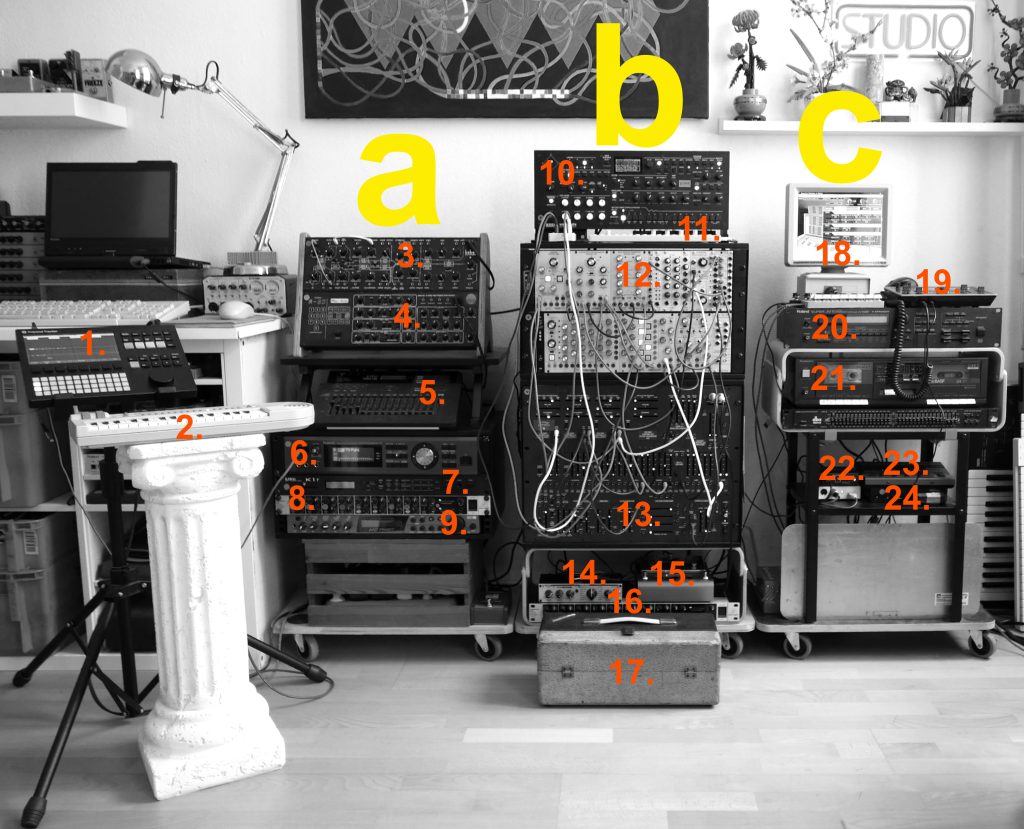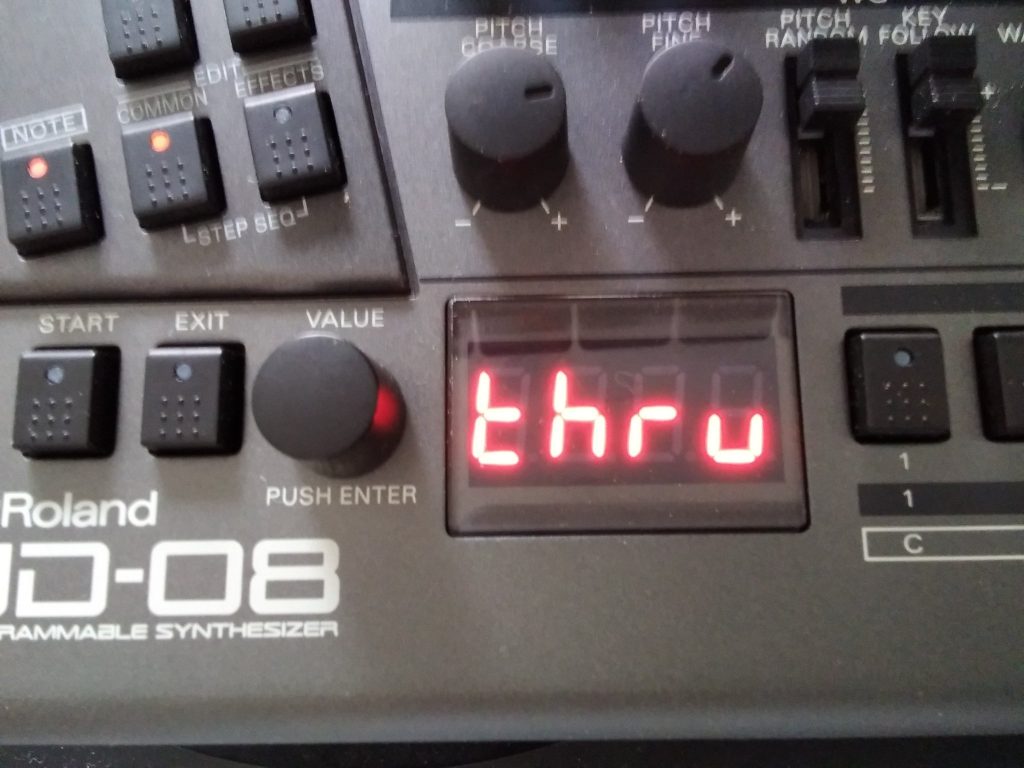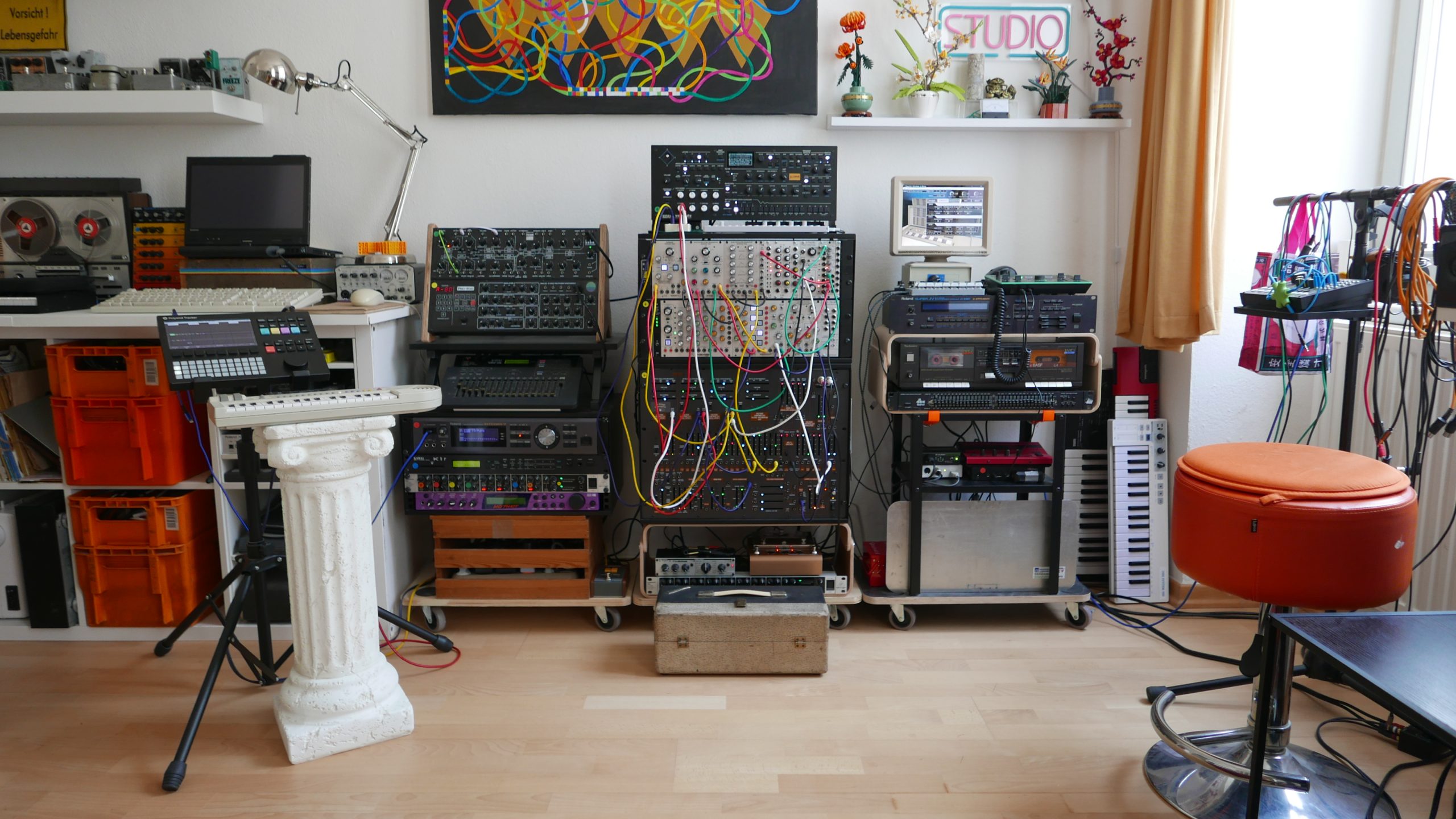A few months back a friend asked about what all of this equipment at Modem Park Studio does. It’s a fair question, so here is an attempt at an answer:

There are three main racks. All three are on wheels so that they can easily be moved to other rooms or wheeled out to allow easy access to cabelling at the rear. a) is the Pads Rack – largely analogue and digital devices with a fairly conventional melodic or harmonic output. b) is the Modular Rack, although this also features some non-modular equipment. c) is the Sallytron Rack, which is mostly equipment related to the vocaloid computer used for Sally’s voice.
In addition there are a few devices on a column and a stand to the left.
1. Polyend Tracker – sampler/sequencer loosely modelled on Amiga tracker software. Amiga trackers were where the Entropy Circus began in the early 90s, but this is a far more powerful and capable device than trackers were back in the day.
2. Casio GZ-5 + Bastl MIDI Looper – minikeys MIDI keyboard and MIDI looper attached to the Pads Rack.
Pads Rack
3. Kobol Expander – Behringer copy of a 70s French analogue monosynth. The bass machine.
4. Pro-800 – Behringer copy of the Prophet 600 analogue polysynth. Most of our pads are digital, but layering this onto the mix helps to add warmth. Also nice having those controls right at the fingertips.
5. Kawai MM-16 – programmer for the Kawai K1R and MIDI faders for Integra-7 orchestration. Unbelievably useful.
6. Integra-7 – Roland’s flagship mega-rompler. Realistic strings, keys, brass and so on. Boasts SuperNATURAL modelling technology as well as most of the Roland legacy PCM instruments. Also contains a huge selection of Boss/Roland effects which can be deployed by both internal sounds and external inputs. Pretty much an encyclopedia.
7. Kawai K1R – rack-mounted version of the Kawai K1 digital synth. Our first real synth was a K1, but we mostly use this for the AM between 8-bit single-cycle waveforms feature. Not many things can do that and sound as great.
8. Eurorack Pro – 16 channel stereo mixer. Yeah, it’s Behringer; sue me!
9. E-MU Mo-Phatt – an “urban dance synth” although it’s mostly here because it can run up to 16 parallel arpeggiators at MIDI clock speeds as low as 1bpm, so in practice it’s being used as a tectonic orchestrator machine.
Modular Rack
10. Korg Wavestate Module – The Wavesequencing 2.0 machine. A really groundbreaking device from Korg and one that we use in a lot of different ways. And yes, it’s impossible to explain how they work.
11. Teenage Engineering OP-1 – arpeggiating, drums, synths, sampling, loop recording, radio and occasionally keys. Really quite useful and beautiful in spite of being an awful hipster toy. Often deployed with the Sallytron.
12. 2500 rack – mostly Rob Keeble’s copies of ARP 2500 modules for Behringer, and some other Doepfer, Ladik and 2hp modules that looked cute.
13. 2600 – Rob Keeble’s ARP 2600 semi-modular for Behringer. The version with Xmas tree lights, of course. Mostly this and the 2500 stuff make telephone exchange noises. Whatever that means.
14. TC Electronic M100 – mini-rack multi-effector which is permanently set to cathedral reverb. Why would it do anything else?
15. T-Rex Replicator D’Luxe – contemporary tape echo. Runs into the M100.
16. Eurorack Pro – yes, another mixer. The Pads Rack mixer and the Sallytron Rack both run into this. The effects loop contains the Replicator(15) and the M100(14).
17. Watkins Copicat – just in case we need more and dirtier tape echo.
Sallytron Rack
18. The Sallytron controls – a vintage-style mini monitor for the Sallytron PC, that either displays the Plogue AlterEgo vocaloid VSTi or the Nord Micro Modular patcher software. We also have two octaves of mechanical keys and an eight knob MIDI controller for various AlterEgo functions. All three of those were made by Parks Tool in Finland.
19. Roland VT-3 – vocal transformer with vocoders, formant and pitch shifters and various other features. Also functions as a volume control for the Sallytron.
20. Roland JV-1080 – the Integra-7’s great predecessor. Mostly used for EWI wind controller voices these days. Still sounds fab.
21. Technics RS D550W – double cassette deck, for those times when we need to insert found tape material into the mix. You wouldn’t understand.
22. MIDI interfaces – Kenton MIDI USB Host MkII – chiefly used to connect the OP-1 to the Sallytron, but also to connect the Sonuus i2M (too small to see here) between the Modular Rack and pretty much anything else. M-Audio MIDIsport 2×2 – workhorse MIDI interface both for the Nord Micro Modular patcher and the Sallytron PC.
23. Nord Micro Modular – early 00s digital synth that thinks its a modular system. Quite limited compared with contemporary VSTi options but actually sounds great.
24. Sallytron PC – Lenovo ThinkCentre M715q Tiny. Sally’s heart and soul, and also the programmer software host for the Nord Micro Modular. Windows 10, because AlterEgo doesn’t run on Linux, before you ask.
Why?
Well, after a lot of experimentation around 2020 with DAWs and VSTis, it turned out that a lot of that technology was unstable and therefore by the time we had it working correctly on any given day we had lost the will to do anything with it. So to this end we looked for hardware options wherever possible. The last VSTi we couldn’t replace at all was AlterEgo. There is no hardware equivalent. However to avoid most of the problems inherent in the technology we set it up on a cheap refurbished ThinkCentre with a cool-looking screen that has never been connected to the internet and never gets any updates.
At the moment it seems to work fairly well.

